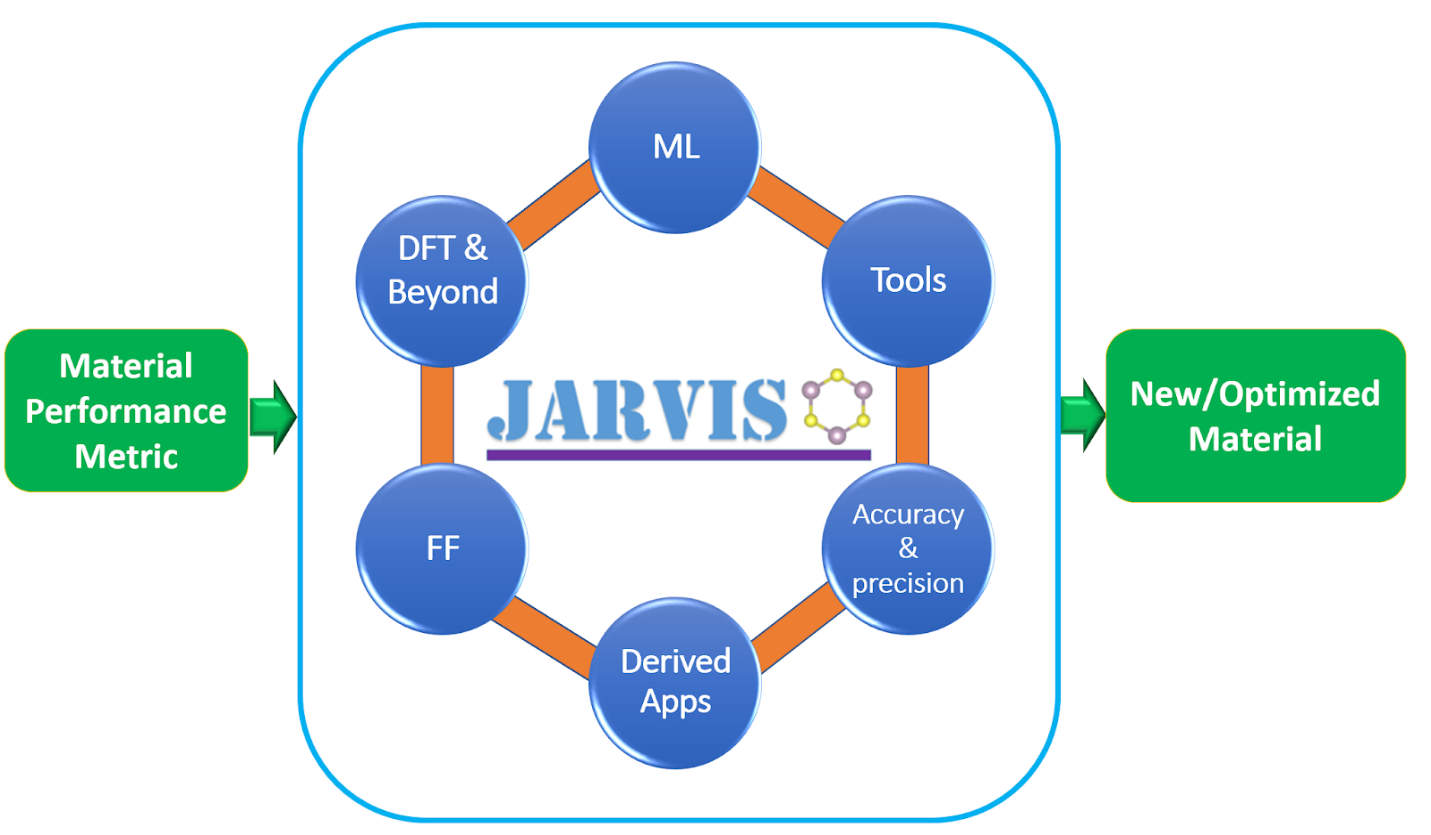User-registration is free, click on the Login/Sign up button. Access to the database and web apps requires user credentials. Find more details about JARVIS in: Nature Portfolio, AIP and other publications. For upcoming events, checkout the JARVIS-Events page.
Overview
Established: January, 2017
Funding: MGI, CHIPS
Published articles: 45+
Citations: 3500+
Users: 150000+
Data downloads: 1 million+
Materials: 80000+
Properties: 1 million+
Several databases, webapps, tutorials and tools.
Integrated tools

For a given materials performance metric, several JARVIS components can work together to design optimized or completely new materials.
Introduction video
This video presents a short ~1 minute introduction to JARVIS.
Databases
| Name | URLs | Description |
|---|---|---|
| 1. JARVIS-DFT | https://jarvis.nist.gov/jarvisdft | Density Functional Theory (DFT) calculation database for 80000+ materials, millions of properties using OptB88vdW and TBmBJ methods, with/without spin-orbit coupling. |
| 2. JARVIS-FF | https://jarvis.nist.gov/jarvisff | Classical force-field (FF) calculation database for ~2000 materials, >100 Classical FFs |
| 3. JARVIS-QETB | https://jarvis.nist.gov/jarvisqetb | Density functional theory database for 800000+ materials using PBEsol method. |
| 4. JARVIS-ChemNLP | https://jarvis.nist.gov/jarvischemnlp | Database of open access papers based on chemical formula filters. |
| 5. JARVIS-Leaderboard | https://pages.nist.gov/jarvis_leaderboard/ | A large collection of benchmark methods for materials design methods including theory and experiments, to enhance transparency and reproducibility, with >300 benchmarks, 9 million data points |
| 6. JARVIS-Tools-Notebooks | https://github.com/JARVIS-Materials-Design/jarvis-tools-notebooks | A Jupyter/Google-Colab Notebook Collection for Materials Design. |
| 7. JARVIS-OPTIMADE | https://jarvis.nist.gov/optimade/jarvisdft/ | Open Databases Integration for Materials Design (OPTIMADE) API for JARVIS-DFT data. |
| 8. JARVIS-Universal Search | https://jarvis.nist.gov/jarvisus | Integrated search for multiple databases. |
| 9. JARVIS-DMFT | https://jarvis.nist.gov/jarvisbdft | Dynamical Mean Field Theory Database. |
| 10. FigShare curated datasets | https://pages.nist.gov/jarvis/databases/ | FigShare based databases. |
WebApps
| Name | URLs | Description |
|---|---|---|
| 1. ALIGNN property predictor | https://jarvis.nist.gov/jalignn/ | Atomistic Line Graph Neural Network for fast property prediction. |
| 2. ALIGNN Force-field | https://jarvis.nist.gov/jalignnff/ | Atomistic Line Graph Neural Network Force-field for fast structure optimization. |
| 3. Solar cells | https://jarvis.nist.gov/jarvissolar | Predict theoretical solar cell performance of a material. |
| 4. Direct Air Capture | https://jarvis.nist.gov/jdac | Predicts CO2 adsorption isotherm of an input metal organic framework. |
| 5. Scanning Tunneling Microscopy | https://jarvis.nist.gov/jarvisstm | Tersoff-Hamann approach based scanning tunneling microscopy images. |
| 6. Scanning Transmission Electron Microscopy | https://jarvis.nist.gov/jstem | Scanning transmission electron microscopy (STEM) using convolution approximation. |
| 7. Heterostructure | https://jarvis.nist.gov/jarvish | Zur algorithm based designing of material interfaces/heterostructures. |
| 8. Catalysis | https://jarvis.nist.gov/jcatalysis | Predicts adsorption energy of a molecule on a substrate. |
| 9. JARVIS-Visualization | https://jarvis.nist.gov/jarvisviz | Quick atomic structure visualizer. |
| 10. JARVIS-XRD | https://jarvis.nist.gov/jxrd | Predicts theoretical X-ray diffraction patterns. |
| 11. JARVIS-WTBH | https://jarvis.nist.gov/jarviswtb | Predicts the Wannier Tight-binding Hamiltonian derived properties. |
| 12. JARVIS-ML/CFID | https://jarvis.nist.gov/jarvisml | Classical Force-Field Inspired Descriptors based predicted properties. |
Tools
| Name | URLs | Description |
|---|---|---|
| 1. JARVIS-Tools | https://github.com/usnistgov/jarvis | JARVIS-Tools: An open-source software package for data-driven atomistic materials design. |
| 2. ALIGNN | https://github.com/usnistgov/alignn | ALIGNN: Atomistic Line Graph Neural Network and force-field. |
| 3. JARVIS-Leaderboard | https://github.com/usnistgov/jarvis_leaderboard | JARVIS-Leaderboard: Explore State-of-the-Art Materials Design Methods and Reproducible Benchmarks. |
| 4. AtomGPT | https://github.com/usnistgov/atomgpt | AtomGPT: Atomistic Generative Pretrained Transformer for Forward and Inverse Materials Design. |
| 5. ChemNLP | https://github.com/usnistgov/chemnlp | ChemNLP: A Natural Language Processing based Library for Materials Chemistry Text Data. |
| 6. AtomVision | https://github.com/usnistgov/atomvision | AtomVision: Deep learning framework for atomistic image data. |
| 7. AtomQC | https://github.com/usnistgov/atomqc | AtomQC: Atomistic Calculations on Quantum Computers. |
| 8. InterMat | https://github.com/usnistgov/intermat | InterMat: Interface materials design toolkit. |
| 9. DefectMat | https://github.com/usnistgov/defectmat | DefectMat: Defect materials design toolkit. |
| 10. TB3Py | https://github.com/usnistgov/tb3py | TB3Py: Two- and three-body tight-binding calculations for materials. |
Tutorials
| Name | URLs | Description |
|---|---|---|
| 1. JARVIS-Tools-Notebooks | https://github.com/JARVIS-Materials-Design/jarvis-tools-notebooks | A Jupyter/Google-Colab Notebook Collection for Materials Design. |
| 2. JARVIS-Tools-Tutorials | https://pages.nist.gov/jarvis/tutorials/ | Workflow setup and analysis documentation. |
| 3. JARVIS-Leaderboard-Notebooks | https://pages.nist.gov/jarvis_leaderboard/notebooks/ | Notebooks for contributing to leaderboard. |
Outreach
| Name | URLs | Description |
|---|---|---|
| 1. JARVIS-Publications | https://pages.nist.gov/jarvis/publications/ | Peer-reviewed publications from the JARVIS team. |
| 2. JARVIS-School | https://jarvis.nist.gov/events/school | A tutorial/hands-on session to introduce open-access databases and tools for materials-design. |
| 3. AIMS workshop | https://jarvis.nist.gov/events/aims | Artificial Intelligence for Materials Science workshop. |
| 4. QMMS workshop | https://jarvis.nist.gov/events/qmms | Quantum Matters in Materials Science workshop. |
| 5. ReproHack | https://forms.gle/MfZsW7H7PpLMf8Yb9 | Reproducibility Hackathon. |
| 6. SlideShare | https://www.slideshare.net/KAMALCHOUDHARY4 | Collection of presentation slides. |
| 7. Google group | https://groups.google.com/a/list.nist.gov/g/jarvis | Google group JARVIS related announcements. |
| 8. Guidance/Help/Issues | https://github.com/usnistgov/jarvis/issues | Comment/questions/concerns to share. |
| 9. MATSCI Forum | https://matsci.org/c/jarvis/48/ | Community/discourse on MATSCI. |
Statistics
JARVIS-DFT materials (77096)
JARVIS-FF materials (2538)
JARVIS-ML (1429605)
OptB88vdW electronic bandgaps and formation energies (77096)
TBmBJ bandgaps (18293)
Elastic Tensors (25513)
Topological SOC spillage (11383)
Infrared intensities (4801)
Dielectric function (15860)
2D exfoliation energy (812)
Carrier effective mass (17642)
Piezoelectric tensors (4801)
Seebeck coeff. (23210)
Electric field gradient (11865)
Solar-SLME (8614)
JARVIS-WannierTB (1771)
JARVIS-STM (1432)
JARVIS-Hetero (226778)
Founder and developer: Dr. Kamal Choudhary
Contributors: (Drs.) Francesca Tavazza, Kevin F. Garrity, Daniel Wines, Andrew C. E. Reid, Brian DeCost, Adam J. Biacchi, Ramya Gurunathan, Taner Yildirim, Angela R. Hight Walker, Zachary Trautt, Jason Hattrick-Simpers, A. Gilad Kusne, Andrea Centrone, Albert Davydov, Jie Jiang, Ruth Pachter, Gowoon Cheon, Evan Reed, Ankit Agarwal, Xiaofeng Qian, Vinit Sharma, Houlong Zhuang, Sergei Kalinin, Ghanshyam Pilania, Pinar Acar, Subhasish Mandal, Kristjan Haule, David Vanderbilt, Igor Mazin, Karin Rabe, Mark Kasule.
